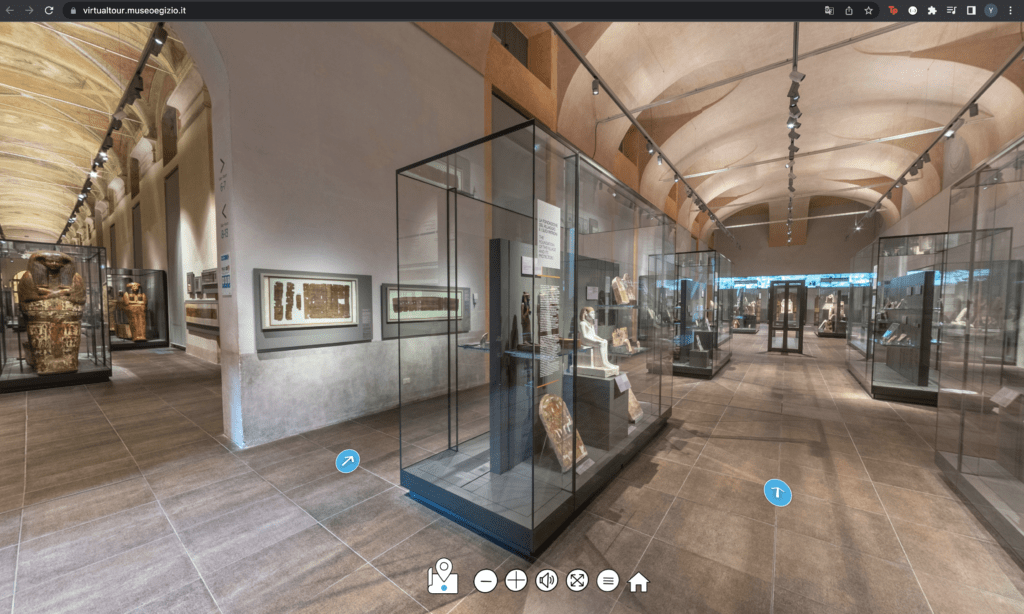Virtual Tour of Museo Egizio
After Christian Greco’s talk, I was prompted to search up the main website of the Egyptian Museum (Museo Egizio in Italian) out of curiosity. An interesting finding was the virtual tour under the tab “Discover the Museum”.
The virtual tour is a 360 degree digital experience in which users can navigate themselves through the museum with photographs and documentations of pieces displayed. When the user clicks on the information button, they can read more about the pieces just as they can in the physical space. The interface includes blue arrows allowing users to “move around” the museum.
Link to the Tour if you’re interested: https://virtualtour.museoegizio.it/

The VR tour encouraged me to think, once again, about the future of museums that Greco mentioned in his talk. He mentioned how COVID expedited the emergence of on-line museums within the last two years. The epidemic required people in all areas of the world to socially distance themselves in the physical space – museums being no exception.
Faced with this challenge, many museums and exhibitions turned to the web to continue providing a digital space where users could continue to engage mentally with the museum’s carefully curated pieces and ideas. The web is a relatively new medium, a powerful one, in which objects stored within it are untouchable to the threats of the physical world.
This relates directly to Greco’s point:
“We cannot preserve without innovation”.
In contexts, such as COVID, where the access to physical objects becomes challenging, adapting to a new medium is essential to continue fulfilling the museum’s role of preserving and creating memory. Preservation and innovation are inseparable.
Relating to the role of museums, Greco mentions how museums cannot be defined or understood outside the realm of societies. Museums provide a space where people can collectively engage in objects and ideas relevant to the culture created in the past, relevant in the present, and those that will be created in the future.
This prompted a question in my head – is social media a hub where all users can be curators of their own digital museums? Where users select moments in the form of images and videos and narrate them through attaching personal meaning to them? These questions made me imagine a near future where people prefer a quick visit to a digital museum over engaging physically in the actual site. How would this impact the role of museums? Would curators actively fight for the preservation of the physical museum? Once the general audience has access to technologies that can create perfect simulations of these physical museums, what would keep these physical museums alive? These questions become ever-more relevant with the collective increase in the time we spend online.
The answer could be simpler than we think. These mediums store the same content and information but they do not feel the same. Just as the experience of reading a physical book differs from that of reading through a screen, visiting a virtual museum will never feel the same as visiting a physical one. Physical museums distinguish themselves through layering each encounter with a feeling that only physical presence could bring.
It seems that the museum not only functions to inform but to provide an experience. In the 2024 project that Greco mentioned, the floor map shows the incorporation of spaces, such as the Egyptian garden and the literary café, that do not serve to exhibit pieces but to fulfill other needs such as eating, breathing fresh air, socializing with others, getting some sun and vitamin D etc. The incorporation of these features is not yet entirely replicable in the digital space. Until we have access to technologies that smoothly encompass all of the 5 senses – sight, touch, smell, hearing, and taste – the physical museum seems to be safe from the digital invasion for a little while.
Additional Questions
-
- Greco mentioned at one point of the talk that we, as humans, think we are powerful but objects are stronger in their ability to last and endure through generations. Digital objects seem to be at the next level of strength in terms of preservation. Does this necessarily make them more valuable? Impermanence and rarity of objects and experiences give objects value. If these digital cultures are imperishable in the form of data, making the contents permanent, how do we measure value in digital objects?
- How does the field of archaeology look like in the digital space? Archaeology is “the scientific study of human activity through the recovery and analysis of material culture.” How does one recover digital culture? Do they not have to be recovered at all?
“Preservation and innovation are inseparable.” Love this point and how you proved it true in your article!